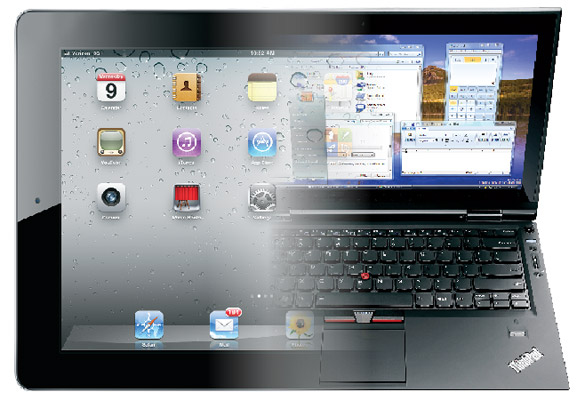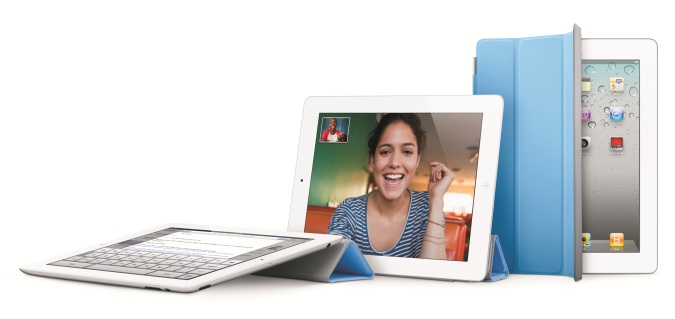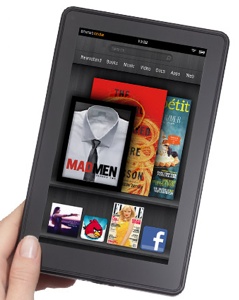Tablets vs. Laptops: What Should You Buy?
It was only a year ago when the iPad was considered a netbook killer—remember netbooks?—but now many people are wondering whether tablets are good enough to replace a full-fledged laptop. The answer is simple: maybe. It really depends on your computing needs. Here’s a quick breakdown of what you should consider before deciding to buy either type of device for yourself or as a gift.
Tablet Pros & Cons
Led by Apple’s iPad 2, tablets are ideal for consuming content. They’re great tools for surfing the web, checking e-mail and Facebook, playing games, reading digital magazines and books, and enjoying movies and music. But that’s not all slates have going for them.
These devices turn on instantly and tend to last longer on a charge than your typical notebook. The best models offer 8 or more hours of unplugged use. That battery life advantage also extends to standby time. With tablets’ phone-like operating systems, you can set them aside for days and they will likely still have plenty of juice left.
The most popular tablet size is 9 to 10 inches, which is similar in dimensions to a magazine, but you’ll also find plenty of devices with 7- or 8-inch screens. These models are more portable, and can more easily fit inside a purse or jacket pocket. The iPad and similarly sized competitors tend to weigh 1.6 pounds or less, while 7- to 8-inch models weigh about a pound or less. Regardless of the size, tablets are lighter and easier to carry than laptops.
Tablets are particularly attractive as gifts because they’re more affordable than most laptops. The iPad 2 starts at $499, and there are several slates that start as low as $199. We haven’t seen many quality devices at that lower price, but it looks like the $199 Amazon Kindle Fire changes that with a great screen, a turbo-charged browser, and easy access to Amazon content. A good notebook costs $200 to $300 more.
As far as productivity goes, tablets are becoming increasingly versatile as more business-friendly apps proliferate. There’s the versatile iWork suite for the iPad, as well as robust third-party options such as Documents to Go and Quickoffice. Similar options are available for Android-based slates. Thanks to such cloud-based services as Dropbox and iCloud, the limited storage capacity of tablets is less of an issue than you might think, though tablets are not very useful without Internet connectivity.
Sign up to receive The Snapshot, a free special dispatch from Laptop Mag, in your inbox.
Some tablets are designed to either pinch-hit for or replace a notebook. The ASUS Eee Pad Slider has a slide-out keyboard built in (pictured), while the Lenovo ThinkPad Tablet lets you take notes with a pen right on its display and comes with an optional keyboard case. Nevertheless, the keyboards on traditional laptops are bigger and more comfortable, and notebooks are simply better at some things, including word processing and video editing.
Laptop Pros & Cons
If the person on your list is looking to get real work done, a laptop continues to be your best bet. For one, they offer a superior text input experience, especially for those who touch type. Laptops also offer better viewing comfort, as they tend to feature larger and sharper screens. For example, the average notebook has a resolution of 1366 x 768 pixels, which fits a lot more information on the display than the 1024 x 768-pixel iPad.
You also shouldn’t overlook the fact that notebooks make it easier to multitask. That’s because you can more quickly switch between applications and see all of your open apps at once. The taskbar in Windows and the Dock on Mac OS X make it a cinch to toggle between programs. And Windows 7 goes one step further with Snap, which allows you to compare open windows side by side. Mission Control in Mac OS X Lion presents your open apps and Spaces on a single screen.
In terms of weight, notebooks are heavier than tablets, but their clamshell design makes outfitting them with a case less necessary. You just toss them in your bag and go.
Another area where notebooks excel is software. Yes, tablets offer access to lots of apps, but laptops pull ahead with the wealth of available productivity programs. Microsoft Office Starter Edition comes pre-loaded on many notebooks. Then there are free apps such as OpenOffice.org (which goes deeper than Office Starter) and Paint.NET for editing photos. And let’s not forget the desktop apps, such as Photoshop, that offer more precision and power than anything you’ll find on a tablet.
Then again, security software is popular for a reason. For now, at least, the vast majority of viruses, Trojans, and other malware live on notebooks. Windows machines are the most popular target by far, but some threats have popped here and there on Macs, too.
So what about price? The average selling price of a laptop is less than $600, and you can get a well-equipped model for an even lower price. For instance, the HP Pavilion g6x features an Intel Core i3 processor, 4GB of RAM, and a 500GB hard drive for $449. This notebook sports a 15.6-inch screen. The sleekest full-power laptops tend to cost more. Apple’s 11-inch MacBook Air starts at $999.
New so-called Ultrabooks follow the Air’s lead with fast boot times and super-slim designs. But the starting price for those machines is about $900. So if that person on your list wants a notebook that behaves more like a tablet, you’re going to pay more.
Verdict
It’s not really a matter of whether tablets are better than laptops or vice versa. It’s about what type of device is right for the job at hand, which is why plenty of people own a laptop and a tablet. But if you’re wondering whether a slate or a notebook is the better gift--or you only have the budget to choose one device or the other--it comes down to what the user plans to do with it. Tablets are better for play and some work, and laptops are better for work and some play.





